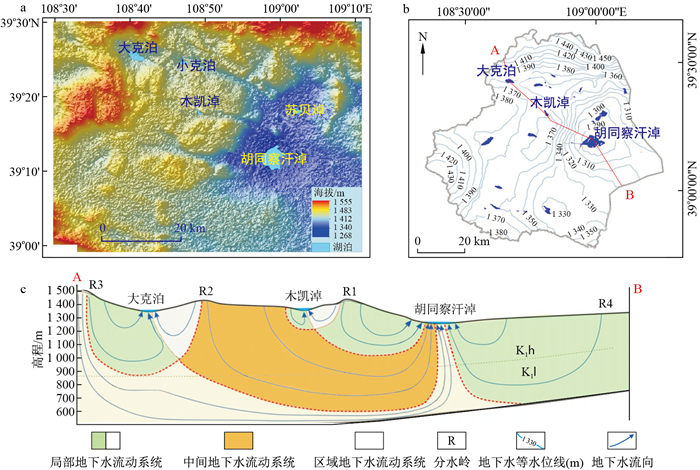| [1] |
梁杏, 张人权, 牛宏, 等. 地下水流系统理论与研究方法的发展[J]. 地质科技情报, 2012, 31(5): 143-151. https://www.cnki.com.cn/Article/CJFDTOTAL-DZKQ201205020.htmLiang X, Zhang R Q, Niu H, et al. Development of the theory and research method of groundwater flow system[J]. Geological Science and Technology Information, 2012, 31(5): 143-151(in Chinese with English abstract). https://www.cnki.com.cn/Article/CJFDTOTAL-DZKQ201205020.htm
|
| [2] |
张人权, 梁杏, 靳孟贵, 等. 水文地质学基础[M]. 第7版. 北京: 地质出版社, 2018.Zhang R Q, Liang X, Jin M G, et al. Fundamentals of hydrogeology[M]. 7th Edition. Beijing: Geological Press, 2018(in Chinese).
|
| [3] |
张人权, 梁杏, 靳孟贵. 地下水流系统: 理论、应用、调查[M]. 北京: 地质出版社, 2015.Zhang R Q, Liang X, Jin M G. Groundwater flow systems: Theorety, application and survey[M]. Beijing: Geological Press, 2015(in Chinese).
|
| [4] |
Currell M J, Han D M, Chen Z Y, et al. Sustainability of groundwater usage in northern China: Dependence on palaeowaters and effects on water quality, quantity and ecosystem health[J]. Hydrological Processes, 2012, 26(26): 4050-4066. doi: 10.1002/hyp.9208
|
| [5] |
Gan Y Q, Zhao K, Deng Y M, et al. Groundwater flow and hydrogeochemical evolution in the Jianghan Plain, central China[J]. Hydrogeology Journal, 2018, 26(5): 1609-1623. doi: 10.1007/s10040-018-1778-2
|
| [6] |
Xiao K, Li H L, Wilson A M, et al. Tidal groundwater flow and its ecological effects in a brackish marsh at the mouth of a large sub-tropical river[J]. Journal of Hydrology, 2017, 555: 198-212. doi: 10.1016/j.jhydrol.2017.10.025
|
| [7] |
Tóth J. A theoretical analysis of groundwater flow in small drainage basins[J]. Journal of Geophysical Research, 1963, 68(16): 4795-4812. doi: 10.1029/JZ068i016p04795
|
| [8] |
Tóth J. Gravitational system of groundwater: Theory, evaluation, utilization[M]. Cambridge: Cambridge University Press, 2009.
|
| [9] |
Müller I, Havril T, Galsa A, et al. Groundwater flow pattern and related environmental phenomena in complex geologic setting based on integrated model construction[J]. Journal of Hydrology, 2016, 539: 330-344. doi: 10.1016/j.jhydrol.2016.05.038
|
| [10] |
Chen J C, Kuang X X, Michele L, et al. Analysis of the groundwater flow system in a high-altitude headwater region under rapid climate warming: Lhasa River Basin, Tibetan Plateau[J]. Journal of Hydrology: Regional Studies, 2021, 36: 100871. doi: 10.1016/j.ejrh.2021.100871
|
| [11] |
Olea-Olea S, Escolero O, Mahlknecht J, et al. Identification of the components of a complex groundwater flow system subjected to intensive exploitation[J]. Journal of South American Earth Sciences, 2020, 98(C): 102434.
|
| [12] |
张俊, 侯荣哲, 尹立河, 等. 盆地地下水流系统形成与影响因素分析[J]. 水文地质工程地质, 2017, 44(4): 8-14. https://www.cnki.com.cn/Article/CJFDTOTAL-SWDG201704002.htmZhang J, Hou R Z, Yin L H, et al. Formation and influencing factors of regional groundwater flow systems[J]. Hydrogeology & Engineering Geology, 2017, 44(4): 8-14(in Chinese with English abstract). https://www.cnki.com.cn/Article/CJFDTOTAL-SWDG201704002.htm
|
| [13] |
Mádl-Szönyi J, Tóth Á. Basin-scale conceptual groundwater flow model for an unconfined and confined thick carbonate region[J]. Hydrogeology Journal, 2015, 23(7): 1-22.
|
| [14] |
Gebere A, Kawo N S, Karuppannan S, et al. Numerical modeling of groundwater flow system in the Modjo River catchment, Central Ethiopia[J]. Modeling Earth Systems and Environment, 2020, 7(4): 1-15.
|
| [15] |
Dai X, Xie Y Q, Simmons C T, et al. Understanding topography-driven groundwater flow using fully-coupled surface-water and groundwater modeling[J]. Journal of Hydrology, 2021, 594: 125950. doi: 10.1016/j.jhydrol.2020.125950
|
| [16] |
Tóth J. Mapping and interpretation of field phenomena for groundwater reconnaissance in a prairie environment, Alberta, Canada[J]. International Association of Scientific Hydrology Bulletin, 1966, 11(2): 20-68. doi: 10.1080/02626666609493458
|
| [17] |
Zhang J, Wang X S, Yin L, et al. Inflection points on groundwater age and geochemical profiles along wellbores light up hierarchically nested flow systems[J]. Geophysical Research Letters, 2021, 48(16): e 2020GL092337.
|
| [18] |
Jiang X W, Wan L, Wang J Z, et al. Field identification of groundwater flow systems and hydraulic traps in drainage basins using a geophysical method[J]. Geophysical Research Letters, 2014, 41(8): 2812-2819. doi: 10.1002/2014GL059579
|
| [19] |
Wang H, Jiang X W, Wan L, et al. Hydrogeochemical characterization of groundwater flow systems in the discharge area of a river basin[J]. Journal of Hydrology, 2015, 527: 433-441. doi: 10.1016/j.jhydrol.2015.04.063
|
| [20] |
Pan G F, Li X Q, Zhang J, et al. Groundwater-flow-system characterization with hydrogeochemistry: A case in the lakes discharge area of the Ordos Plateau, China[J]. Hydrogeology Journal, 2019, 27(2): 669-683. doi: 10.1007/s10040-018-1888-x
|
| [21] |
Carrillo-Rivera J J, Varsanyi I, Kovacs L O, et al. Tracing groundwater flow systems with hydrogeochemistry in contrasting geological environments[J]. Water Air & Soil Pollution, 2007, 184(1/4): 77-103.
|
| [22] |
梁杏, 张婧玮, 蓝坤, 等. 江汉平原地下水化学特征及水流系统分析[J]. 地质科技通报, 2020, 39(1): 21-33. https://www.cnki.com.cn/Article/CJFDTOTAL-DZKQ202001004.htmLiang X, Zhang J W, Lan K, et al. Hydrochemical characteristics of groundwater flow systems in Jianghan Plain[J]. Bulletin of Geological Science and Technology, 2020, 39(1): 21-33(in Chinese with English abstract). https://www.cnki.com.cn/Article/CJFDTOTAL-DZKQ202001004.htm
|
| [23] |
魏兴, 周金龙, 梁杏, 等. 新疆喀什三角洲地下水流系统的水化学和同位素标记[J]. 地球科学, 2020, 45(5): 1807-1817. https://www.cnki.com.cn/Article/CJFDTOTAL-DQKX202005023.htmWei X, Zhou J L, Liang X, et al. Hydrochemical and isotopic markers of groundwater flow systems in the Kashagar Delta area in Xinjiang[J]. Earth Science, 2020, 45(5): 1807-1817(in Chinese with English abstract). https://www.cnki.com.cn/Article/CJFDTOTAL-DQKX202005023.htm
|
| [24] |
吴春勇, 苏小四, 郭金淼, 等. 鄂尔多斯沙漠高原白垩系地下水水化学演化的多元统计分析[J]. 世界地质, 2011, 30(2): 244-253. doi: 10.3969/j.issn.1004-5589.2011.02.013Wu C Y, Su X S, Guo J M, et al. Multivariate statistical analysis of hydrogeochemical evolution of groundwater in Cretaceous aquifer Ordos desert plateau[J]. Global Geology, 2011, 30(2): 244-253(in Chinese with English abstract). doi: 10.3969/j.issn.1004-5589.2011.02.013
|
| [25] |
林永生, 裴建国, 杜毓超, 等. 基于多元统计方法的岩溶地下水化学特征及影响因素分析[J]. 环境化学, 2016, 35(11): 2394-2401. doi: 10.7524/j.issn.0254-6108.2016.11.2016032801Lin Y S, Pei J G, Du Y C, et al. Hydrochemical characteristics of karst groundwater and their influencing factors based on multiple statistical analysis[J]. Environmental Chemistry, 2016, 35(11): 2394-2401(in Chinese with English abstract). doi: 10.7524/j.issn.0254-6108.2016.11.2016032801
|
| [26] |
Belkhiri L, Boudoukha A, Mouni L A. Multivariate statistical analysis of groundwater quality data[J]. International Journal of Environmental, 2011, 5(2): 537-544.
|
| [27] |
Roger P C, Julia P Á, Ye M, et al. Groundwater quality: Analysis of its temporal and spatial variability in a karst aquifer[J]. Groundwater, 2018, 56(1): 62-72. doi: 10.1111/gwat.12546
|
| [28] |
Yang J, Ye M, Tang Z H, et al. Using cluster analysis for understanding spatial and temporal patterns and controlling factors of groundwater geochemistry in a regional aquifer[J]. Journal of Hydrology, 2020, 583: 124594. doi: 10.1016/j.jhydrol.2020.124594
|
| [29] |
张俊, 刘天罡, 董佳秋, 等. 含水层层状非均质对地下水流系统的影响[J]. 中国地质, 2020, 47(6): 1715-1725. https://www.cnki.com.cn/Article/CJFDTOTAL-DIZI202006010.htmZhang J, Liu T G, Dong J Q, et al. The impact of aquifer layered heterogeneity on groundwater flow system[J]. Geology in China, 2020, 47(6): 1715-1725(in Chinese with English abstract). https://www.cnki.com.cn/Article/CJFDTOTAL-DIZI202006010.htm
|
| [30] |
孙芳强. 鄂尔多斯盆地都思兔河流域地下水循环及生态环境效应研究[D]. 西安: 长安大学, 2010.Sun F Q. Study on groundwater circulation and ecological effects in Dusitu River basin of Ordos Basin[D]. Xi'an: Chang'an University, 2010(in Chinese with English abstract).
|
| [31] |
张晶, 刘运德, 周爱国, 等. 硝酸盐污染地下水中溶解性有机质光谱特征及其指示意义: 以鄂尔多斯盆地北部湖泊集中区为例[J]. 地质科技情报, 2019, 38(4): 262-269. https://www.cnki.com.cn/Article/CJFDTOTAL-DZKQ201904028.htmZhang J, Liu Y D, Zhou A G, et al. Spectral characteristics of dissolved organic matter and their implications in groundwater contaminated by nitrate of lake concentration area in northern Ordos Basin[J]. Geological Science and Technology Information, 2019, 38(4): 268-275(in Chinese with English abstract). https://www.cnki.com.cn/Article/CJFDTOTAL-DZKQ201904028.htm
|
| [32] |
江欣悦, 李静, 郭林, 等. 豫北平原浅层地下水化学特征与成因机制[J]. 地质科技通报, 2021, 40(5): 290-300. https://www.cnki.com.cn/Article/CJFDTOTAL-DZKQ202105030.htmJiang X Y, Li J, Guo L, et al. Chemical characteristics and formation mechanism of shallow groundwater in the northern Henan Plain[J]. Bulletin of Geological Science and Technology, 2021, 40(5): 290-300(in Chinese with English abstract). https://www.cnki.com.cn/Article/CJFDTOTAL-DZKQ202105030.htm
|
| [33] |
梁辉. 鄂尔多斯盆地北部湖泊集中区地下水水化学特征和硫酸盐来源同位素识别[D]. 武汉: 中国地质大学(武汉), 2017.Liang H. Characterization of groundwater chemistry and isotopic identification of sulfate sources in the lake concentration area in the northern Ordos Basin[D]. Wuhan: China University of Geosciences(Wuhan), 2017(in Chinese with English abstract).
|
| [34] |
连英立, 张光辉, 聂振龙, 等. 西北内陆张掖盆地地下水温度变化特征及主要影响因素识别[J]. 干旱区地理, 2011(3): 391-399. https://www.cnki.com.cn/Article/CJFDTOTAL-GHDL201103002.htmLian Y L, Zhang G H, Nie Z L, et al. Groundwater temperature variation characteristics and main influence factors identification in Zhangye Basin of northwest China[J]. Arid Land Geography, 2011(3): 391-399(in Chinese with English abstract). https://www.cnki.com.cn/Article/CJFDTOTAL-GHDL201103002.htm
|
| [35] |
吴志伟, 宋汉周. 地下水温度示踪理论与方法研究进展[J]. 水科学进展, 2011, 22(5): 733-740. https://www.cnki.com.cn/Article/CJFDTOTAL-SKXJ201105023.htmWu Z W, Song H Z. Temperature as a groundwater tracer: Advances in theory and methodology[J]. Advances in Water Science, 2011, 22(5): 733-740(in Chinese with English abstract). https://www.cnki.com.cn/Article/CJFDTOTAL-SKXJ201105023.htm
|
| [36] |
Yin L H, Hou G C, Su X S, et al. Isotopes (δD and δ18O) in precipitation, groundwater and surface water in the Ordos Plateau, China: Implications with respect to groundwater recharge and circulation[J]. Hydrogeology Journal, 2011, 19(2): 429-443. doi: 10.1007/s10040-010-0671-4
|





 下载:
下载:












